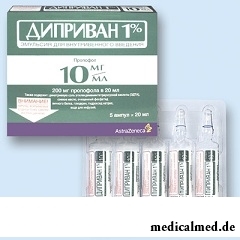





Diprivan
Application instruction:
 Diprivan – drug for not inhalation general anesthesia and sedation.
Diprivan – drug for not inhalation general anesthesia and sedation.
Form of release and structure
Diprivan release in the form of an emulsion for intravenous administration: almost white or white homogeneous substance, practically without foreign impregnations, perhaps easy stratification at long standing (on 20 ml in glass transparent ampoules, on 5 ampoules in plastic fixers, on 1 fixer in a cardboard box; on 50 ml in the glass syringe with Lyuer's connector and a polypropylene plunger, on 1 syringe in blister strip packagings, on 1 packaging in a cardboard box).
1 ml of an emulsion contains:
- Active ingredient: пропофол – 10 mg;
- Auxiliary components: disodium salt of ethylene diamine tetraacetic acid (EDTA), oil of soybeans, глицерол, phospholipids of an egg yolk, sodium hydroxide, water for injections.
Indications to use
Diprivan apply as shortly operating anesthetizing drug to intravenous administration at an introduction anesthesia and to maintenance of the general anesthesia.
Diprivan apply to achievement and maintenance of sedation in the presence of the following indications:
- Artificial ventilation of the lungs (for suppression of consciousness when carrying out an intensive care at adult patients);
- Diagnosis and surgical interventions (for holding procedures at the patients who are in consciousness).
Contraindications
- Age up to 3 years;
- Allergic reaction to drug in the anamnesis;
- Hypersensitivity to drug components.
Diprivan's use for the purpose of providing sedation for an intensive care at children of all age groups at grain or an epiglottiditis is contraindicated.
With care it is necessary to use drug at patients with respiratory, cardiac, hepatic or renal pathologies, and also at a hypovolemia and at the weakened patients.
Diprivan gets through a placental barrier, its use can become the reason of a neonatal depression. Therefore it cannot be applied to anesthesia in obstetrics and during pregnancy, an exception is abortion (abortion) in the first trimester.
Safety of use of drug in the period of a lactation (breastfeeding) was not established.
Route of administration and dosage
As a rule, additional use of analgeziruyushchy drugs / substances along with Diprivan is required.
Pharmacological incompatibility when using a propofol in combination with epidural and spinal anesthesia, muscle relaxants, means for premedication was not noted, inhalation analgetics and anesthetics. If the general anesthesia is used as addition to the applied methods of regional anesthesia, the dose decline of a propofol can be required.
Use of drug for adult patients:
- Induction of the general anesthesia: the introduction anesthesia is carried out by means of infusion or slow bolyusny injections; irrespective of carrying out premedication, Diprivan's introduction should be titrated (infusion or bolyusny injections ~ 40 mg / 10 sec. – for the adult patient in satisfactory condition) depending on reaction of the patient before emergence of clinical signs of an anesthesia. An average dose of a propofol for most of adults aged up to 55 years – 1,5-2,5 mg/kg. It is possible to reduce a required total dose, administering the drug more slowly, with a speed of 20-50 mg/min. For patients 55 years, as a rule, are more senior lower dose is necessary; sick III and IV classes on a scale of the American association of anesthesiologists (ASA) introduction needs to be carried out with lower speed (~ 20 mg / 10 sec.);
- Maintenance of the general anesthesia: it is carried out by continuous infusion or repeated bolyusny injections for maintenance of required depth of anesthesia. At continuous infusion rate of administering significantly varies and depends on specific features of patients (as a rule, introduction with a speed of 4-12 mg/kg/h guarantees maintenance of an adequate state). In case of use of the equipment of repeated bolyusny injections introduction of the accruing doses, depending on clinical requirement, from 25 to 50 mg is used;
- Providing sedation during an intensive care: for achievement of sedation at the adults who are on IVL receiving an intensive care, Diprivan is recommended to apply by means of continuous infusion, adjusting speed depending on the necessary depth of sedation (normal the speed indicator within 0,3-4,0 mg/kg/h has to provide satisfactory effect);
- Providing sedation with preservation of consciousness at patients during the diagnostic and surgical procedures: speed of infusion and a dose is selected individually and depends on clinical reaction of the patient. A standard dose for achievement of sedation – 0,5-1,0 mg/kg in 1-5 minutes, for the purpose of maintenance of sedation adjust speed according to the necessary depth of sedation (for most of patients the speed of infusion varies within 1,5-4,5 mg/kg/h). If necessary quickly to increase sedation depth, as addition to infusion it is possible to use bolyusny introduction of 10-20 mg of a propofol. Patients III and IV classes on ASA scale perhaps will require a dose decline and rates of administering.
It is not recommended to use system ITsK "Diprifyyuzor" at adult patients for the purpose of providing sedation for an intensive care and sedation with consciousness preservation.
Use for patients of advanced age:
- The introduction anesthesia – is used by lower doses of a propofol, the dose is reduced according to age of the patient and his physical status; the reduced dose is entered with a speed, smaller, than usually, and titrated depending on reaction of the patient;
- Maintenance of anesthesia or providing sedation – "target concentration" or speed of infusion has to be reduced.
Elderly patients III and IV classes on ASA scale perhaps will need further reduction in the rate of administration of drug and its dose.
In order to avoid oppression of respiratory and cardiovascular systems by the elderly patient bystry single or repeated bolyusny introduction is not recommended.
Diprivan's use at children's age:
- Induction of the general anesthesia: slow introduction of a propofol is recommended to children before emergence of clinical signs of approach of anesthesia. The dose is adjusted according to the weight and/or age of the child (for most of patients 8 years a probable dose are more senior will make 2,5 mg/kg, to children 8 years, perhaps are younger, higher dose is required). Reduction of a dose of drug is recommended for children III and IV classes on ASA scale;
- Maintenance of the general anesthesia: it is reached by Diprivan's introduction by means of repeated bolyusny injections or continuous infusion in the doses necessary for maintenance of required depth of anesthesia. Rate of administering considerably differs at various patients (satisfactory anesthesia is reached usually at a speed of infusion within 9-15 mg/kg/h);
- Providing sedation with preservation of consciousness at diagnostic and surgical procedures: at children it is not recommended to apply пропофол to sedation with consciousness preservation as its efficiency and safety at such use are not confirmed yet;
- Providing sedation during an intensive care: Diprivan is not recommended to apply to sedation at children as its efficiency and safety at such use are not confirmed yet. In case of unlicensed use serious adverse by-effects were noted (including with a lethal outcome), it was not succeeded to establish a causal relationship of such effects using Diprivan. Most often the adverse phenomena were observed at children with respiratory infections at introduction of the doses of drug exceeding the recommended doses for adults.
At any indications at children's age Diprivan by means of system ITsK "Diprifyyuzor" is not recommended to enter.
Diprivan is allowed to enter suspension not divorced with use of plastic syringes and glass bottles for infusion, or the ready filled glass syringes. At use of drug in not divorced view with the purpose of maintenance of the general anesthesia, for control of speed in maintaining it is necessary to use infuzomata or perfusors.
Diprivan also apply only the dextrose solution divorced 5% to intravenous administration, in glass bottles or bags from PVC. Cultivation should not be more ratio 1:5 (2 mg »Ó«»«õ«½á/ml), it is necessary to prepare solution just before use according to rules of an asepsis. Mix is stable within 6 hours.
It is possible to enter divorced solution of Diprivan, using various adjustable systems for infusion, but it is necessary to consider that use only of similar devices will not help to avoid completely risk of uncontrollable accidental administration of drug in large volumes. The structure of the line for infusion has to always switch on counters of drops, burettes or dispensing pumps. Choosing in the burette value of the maximum volume for a divorced propofol needs to be remembered risk of uncontrollable introduction.
It is possible to enter an emulsion through a tee with the valve near the place of an injection, along with administration of solution for intravenous injection: 0.9% of solution of sodium of chloride, 5% of solution of a dextrose or 4% of solution of a dextrose from 0,18% chloride sodium solution. The glass syringe ready to the use has the smaller resistance of the piston in comparison with the one-time plastic syringe therefore it is easier set in motion. Entering Diprivan manually by means of the glass syringe ready to the use, it is impossible to leave open system for infusion between the syringe and the patient in case of lack of observation from medical personnel.
The corresponding compatibility when using the glass syringe with Lyuer's connector and a polypropylene plunger has to be provided, and the spray pump. The pump design, in particular, has to prevent siphoning and provide the alarm system about obstruction with a pressure which is not exceeding 1000 mm hg. When the pump programmable or equivalent to it is used, the possibility of use of various syringes is supposed; in case of use of the glass syringe ready to the use, it is possible to set only PLASTIPAK ml mode "B-D" 50/60. Propofol it is possible to mix previously with alfentanily (500 mkg/ml) for injections, in a volume ratio 20:1-50:1. Mix should be prepared with use of the sterile equipment and to apply within 6 hours after preparation.
For reduction of pain from introduction of an induction dose just before introduction Diprivan it is possible to mix in the plastic syringe from 0,5% or 1% lignocainum solution for injections in a proportion 20:1.
Side effects
Usually induction of anesthesia proceeds smoothly, signs of excitement of the patient are minimum. The side reactions meeting more often the others (for example, hypotension), are predictable from the point of view of pharmacology, and are characteristic of any means for the general anesthesia.
Cases about which it was reported in connection with an intensive care and anesthesia (conditions of the patient or procedures received by it can be also a consequence):
- The general reactions, reactions in an injection site: very often – pain in an injection site at induktsii1;
- The general: often – a withdrawal at detey4;
- Cardiovascular system (CCC): often – gipotenziya2, bradikardiya3, rush of blood at detey4; infrequently – phlebitis and thromboses; very seldom – a fluid lungs;
- Digestive Tract (DT): often – vomiting and nausea during an exit from an anesthesia; seldom – pancreatitis;
- Central Nervous System (CNS): often – a headache in the course of awakening; seldom – the epileptiform movements, including an opisthotonos and convulsions during induction, in the course of anesthesia and when awakening; very seldom – unconsciousness after operation;
- Respiratory system: often – temporary an apnoea at an introduction anesthesia;
- Skeletal and muscular effects, connecting fabric: seldom – rabdomioliz5;
- Procedural complications: seldom – postoperative fever;
- Kidneys and urinary system: very seldom – decolouration of urine as a result of long use;
- Immune system: very seldom – an anaphylaxis (a Quincke's disease, a bronchospasm, an erythema, hypotension);
- Reproductive system: very seldom – a sexual disinhibition.
Notes:
1 – it is possible to reduce pain in an injection site entering suspension into veins of an elbow bend and a forearm, big by the size; also pain can be reduced at joint introduction of Diprivan with 1% lignocainum solution.
2 – at hypotension perhaps it will be required to enter intravenously liquid and to reduce Diprivan rate of administering.
3 – serious cases of delay of cordial activity (bradycardia) meet seldom, except for the isolated messages on progressing of bradycardia up to an asystolia.
4 – the withdrawal (including rush of blood) at children arises only at sharp phase-out of drug during an intensive care.
5 – there are data on very exceptional cases of a rabdomioliz when Diprivan was applied in doses of more than 4 mg/kg/h at an intensive care to sedation.
In case of overdose oppression of activity of CCC and breath is possible. At respiratory depression it is necessary to carry out artificial ventilation of the lungs with oxygen. At oppression of cardiovascular activity it is necessary to hang the patient's head down, in hard cases introduction of pressor and plasma substituting means is not excluded.
Special instructions
It is authorized to enter Diprivan only to personnel with special preparation in the field of anesthesia, and to the health workers who had training on assistance to patients during an intensive care in the corresponding situations.
For patients it is necessary to carry out continuous monitoring. The room in which administration of drug is carried out has to be equipped with system for carrying out artificial ventilation of the lungs, the equipment for maintenance of free passability of respiratory tracts, oxygen enrichment, and also other resuscitation means constantly ready to use.
The specialist performing the surgical or diagnostic procedure should not carry out Diprivan's introduction.
In the course of Diprivan's use for diagnostic or surgical procedures, for the purpose of providing sedation at the kept consciousness, continuous monitoring of the patient is necessary for obstruction of respiratory tracts and hypotension for early detection of precursory symptoms of insufficient saturation of blood oxygen.
When using Diprivan's for the purpose of providing sedation during an operative measure, as well as in case of use of other sedative drugs, patients have a probability of involuntary movements which can be dangerous to the site of an operative measure at the procedures demanding an immobilization.
It is required to watch the patient for providing its complete recovery after the general anesthesia throughout an adequate span. In extremely exceptional cases as a result of Diprivan's use lack of consciousness in the postoperative period is possible that can be followed by increase in a muscle tone. The loss of consciousness sometimes occurs after the wakefulness period, the probability of spontaneous awakening is not excluded (it is necessary to establish appropriate observation of the patient who is in unconsciousness).
Diprivan has weak vagolytic effect, its use is connected with displays of bradycardia (sometimes serious character) also by asystolias. In this regard, before anesthesia induction, or during maintenance of an anesthesia (especially in case of probable dominance of a vagal tone), and also at use in combination with other means which can become the bradycardia reason, reasonablly intravenous administration of anticholinergic drug.
At administration of anesthetic to the patient with epilepsy there is a risk of developing of spasms.
Patients with disturbances of lipidic metabolism and existence of states which demand use of lipidic emulsions with care should pay special attention. Monitoring of level of lipids is recommended to be carried out to blood at purpose of drug to the patients subject to extra risk of accumulation of fats. At identification as a result of observations of insufficient removal of lipids from an organism it is necessary to carry out dose adjustment. In case of simultaneous intravenous administration of other lipidic means its dose needs to be reduced taking into account quantity of the lipid entered as a part of Diprivan (in 1,0 ml about 0,1 g of fat contain).
As an introduction anesthesia (induction) at newborns, according to the unregistered indications, пропофол can lead to oppression of cardiovascular and respiratory systems in case of use of the standard mode of the dosing recommended for children.
For providing sedation during an intensive care premature newborns have no data on Diprivan's use. Clinical trials of use of suspension for providing sedation during an intensive care at children with a croup or an epiglottiditis were not carried out.
When providing sedation during an intensive care at seriously ill patients of the patients receiving пропофол were seldom or never observed: a metabolic acidosis, рабдомиолиз, a hyperpotassemia, heart failure, in some episodes from the death. Most likely it resulted from insufficient providing fabrics with oxygen. Between Diprivan's use and these cases of a causal relationship it is not established.
All sedative and therapeutic medicines used at an intensive care (including Diprivan), have to be titrated for the purpose of maintenance of optimum hemodynamic parameters and optimum supply with oxygen of body tissues.
Being a part of drug EDTA forms chelate complexes with ions of metals, including with zinc ions. In this regard patients need to consider the possibility of additional purpose of zinc in case of prolonged use of Diprivan, especially, with predisposition to deficit of zinc, for example, at diarrhea, burns and/or sepsis.
Antimicrobic preservatives therefore suspension can be the favorable environment for growth of microorganisms, including pathogenic are not Diprivan's part. Filling with drug the sterile syringe or the infusional line it is important to follow rules of an asepsis, to gather suspension directly after opening of an ampoule, then to immediately begin introduction. It is necessary to provide aseptic conditions during all infusional process concerning the equipment for introduction, and directly for Diprivan. Any infusion solutions added to the infusional line are entered as it is possible closer to the location of a cannula. It is impossible to enter suspension via the microbiological filter.
The syringe with Diprivan – one-time, is intended for use for one patient. According to the rules established including for other lipidic emulsions, the maximum duration of continuous infusion – 12 hours. Capacity with an emulsion and the infusional line is replaced after 12 hour periods or upon termination of infusion.
Before use capacity with an emulsion should be stirred up, and the contents which remained after its use in any quantity need to be destroyed.
It is important to inform patients that for some time after carrying out the general anesthesia deterioration in skills which performance demands the increased concentration of attention and speed of psychomotor reactions, such as driving of the car or work with difficult mechanisms is probable.
Medicinal interaction
Before use Diprivan it is not necessary to mix with other infusion or injection solutions, except 5% of solution of a dextrose in bags from PVC or in glass bottles for injection, an alfentanil or lignocainum for injections in plastic syringes.
Before introduction of muscle relaxants of a mivakurium and atrakurium with use of the same infusional line, as for Diprivan, it should be washed out previously carefully.
Terms and storage conditions
To store in the place, unavailable to children, at a temperature of 2-25 °C, not to freeze.
Period of validity: ampoules – 3 years, syringes – 2 years.
Blood of the person "runs" on vessels under huge pressure and at disturbance of their integrity is capable to shoot of distance to 10 meters.

Striya (extension) are the defects of skin having an appearance of direct or wavy strips from 1 to 10 cm long and 1-5 mm wide. In the majority with...
Section: Articles about health
Phobia – the persuasive fear of a certain contents shown in a specific situation against the will of the person. Concepts of a phobia and fear are similar, however if the fear is natural protective function of mentality, then the phobia is its deviation. So the person can an ispytyva...
Section: Articles about health
Dogrose – one of the most widespread adornment and medicinal plants growing practically in all territory of our country. To most of Russians it is a beautiful bush it is known, first of all, as a source of fruits, extremely vitamin-rich. However curative properties of a dogrose are not limited to it at all. About how still it is possible to use a plant in the medical purposes, we will tell today....
Section: Articles about health
Iodine - one of thirty most important microelements in our organism. The main role of iodine consists in synthesis thyroid гормо...
Section: Articles about health
According to doctors, more than a half of men of 25-50 years suffer from frustration of the urinogenital sphere, but the minority sees a doctor from them. And in vain - even the insignificant discomfort in the field of generative organs can serve as a symptom of an illness fraught heavy посл...
Section: Articles about health
According to World Health Organization, every third inhabitant of Earth has excess weight, and every tenth has obesity. The reason of this phenomenon, according to specialists, roots in one not very comforting fact: most of people consume much more calories, than it is necessary. How it turns out what we overeat? Why it is so difficult to refuse an excess portion tasty or additives? Let's try to find out what factors prevent us to eat food with reasonable moderation....
Section: Articles about health
Cold – a state known to everyone which is followed by cold, cough, high temperature, a pharyngalgia. Often перво...
Section: Articles about health
According to data of World Health Organization, the cataract is diagnosed almost for 7% of the population of Earth. The statistics of incidence is considered not full as at an initial stage the illness, as a rule, does not cause to the person of special inconveniences, and many having got sick...
Section: Articles about health
The depression not without reason is considered one their main troubles of our century: for scientific and technical progress, acceleration of rate of life and a surplus of information of people it is forced to pay with stresses, negative emotions and weakening of protective forces of an organism. As a result widely the states which are characterized by the increased uneasiness, falling of interest in life, spiritual and physical discomfort extend....
Section: Articles about health
Antibiotics - - it is possible to call the chemical compounds suppressing growth of bacteria the break in the field of medicine which allowed to save persons...
Section: Articles about health
Today about 30 diseases, sexually transmitted are known. Wide circulation of these illnesses is extremely promoted by the dual attitude towards them: on the one hand, most of people know about "shameful" diseases and not a stirrup very little...
Section: Articles about health
The pine is one of the most widespread plants of our woods. Its needles and pitch not without reason called by "gallipot" were since ancient times used for strengthening of protective forces of an organism, treatment of avitaminosis, anemia and many other diseases. In recent years wide popularity was gained by the national medicines prepared from pinecones. "Fruits" of a coniferous tree contain a huge amount of vitamins, biologically active agents, antioxidants, phytoncides and other useful to...
Section: Articles about health
It is known that the person for 80% consists of water which participates in all processes of an organism. The person loses liquid daily – in...
Section: Articles about health
Vitamin complexes belong to the most popular drugs, probably, in our country there is no person who was not hearing about advantage of vitamins and never their accepting. The more vitamins, the better, we consider and as it appeared, cruelly we are mistaken. So l...
Section: Articles about health
Statistically, pathologies of a thyroid gland in the world more than 500 million people have. Failures in work of this body lead to heavy disbolism, development of heart diseases, vessels, a reproductive and nervous system. In hard cases excess or insufficient production of the main hormones of a thyroid gland (thyroxine and triiodothyronine) leads to essential decline in quality of life and disability....
Section: Articles about health
The healthy nutrition is the invariable principle of health and good health for long years of the woman. Nevertheless, in рацио...
Section: Articles about health
On health of the person physicians know about salutary action of animals long ago. About 7 thousand years ago great Hippocrates recommended to the patients riding walks for strengthening of a nervous system and increase in vitality....
Section: Articles about health
For the help to doctors in the choice of optimal solutions for treatment of various diseases the Cochrane scientific organization (Cochrane) conducts joint researches with representatives of scientific community around the world. The analysis of a series of the conducted researches of the drug Oscillococcinum® relating to group of cold remedies became one of the last methanolyses....
Section: Articles about health
Eyes – one of the most vulnerable areas on a face therefore age changes concern them first of all. Whether it is possible to keep a pier...
Section: Articles about health
So, you resolved to lose weight. And now you try to understand what to begin with: from exercise stresses or a diet? And how to make that process of weight loss did not give you an inconvenience, and, on the contrary, brought joy?...
Section: Slideshow
Contrary to popular belief, the multiple sclerosis (MS) is not connected neither with sclerous changes of walls of vessels, nor with age forgetfulness and problems with concentration of attention. This disease has the autoimmune nature. Pathological process is expressed in degradation of nervous tissue and destruction of its enveloping layer - a myelin. Multiple damages of the central nervous system which are shown by decrease in sight, bystry fatigue, on become result of development of an illness...
Section: Articles about health
Wood louse – the ordinary-looking unpretentious plant extended in all territory of our country. It quickly expands, and sometimes for...
Section: Articles about health
During foot walks blood moves on vessels more actively and one and all bodies are supplied with a large amount of oxygen. It affects the state of health of the person very positively....
Section: Slideshow
Water with a lemon - idle time in preparation drink which supporters of a healthy lifestyle already managed to appreciate. Used in a warm look and on an empty stomach, it is one of the most useful prophylactics allowing to prevent tens of diseases and just to raise an organism tone. Especially effectively to use warm water with lemon juice after a serious illness, during a season of the colds, and also to children, old men and pregnant women which do not have contraindications...
Section: Articles about health
Proofs of efficiency of Mildronate at treatment of coronary heart disease with stenocardia can be found in many publications to...
Section: Articles about health
All parents are ready to what the baby often and pisat much. Since then, as the absorbing diapers strongly became current, keeping of the kid in dryness does not represent any problems. But if the grown-up kid continues to urinate in panties, parents of a nacha...
Section: Articles about health
Transfusion of donor blood has almost century history. In spite of the fact that this procedure is quite usual for many people, process of blood donation is still surrounded with numerous myths. Today we aimed to discredit the most widespread of them....
Section: Articles about health
